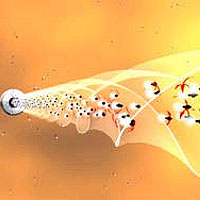| Studies on electric polarization open potential for tinier devices |
While researchers are still probing the unusual properties of the new fibers, tests show the strands impart a chiral, or "handed," character to light by polarizing photons according to certain physical properties. Victor Kopp of Chiral Photonics in Clifton, N.J., and his colleagues describe the new fibers in the July 2 issue of Science. Several of these fibers, and their applications, are being developed in part with funds from the National Science Foundation Small Business Innovation Research program. In conventional optical fibers, light is transmitted from one end to the other through a round core housed within a concentric outer cladding. But, because a circular core does not develop handedness when twisted, the research team wound rectangular-core fibers to create a double helix. When the team tested the twisted fiber, they discovered that some photons left the core and entered the cladding. Photons with the same handedness as the fiber entered the cladding whereas photons with handedness opposite that of the fiber remained in the core. With only a relatively loose twist-roughly 100 microns to form a complete turn-photons with a handedness that coincides with the fiber's twist scatter out of the core at a shallow angle and are trapped in the cladding. With a tighter twist, photons with the same handedness as the fiber scatter at a wider angle, allowing the photons to escape from the cladding into the surrounding space. Only light of a single polarization remains in the fiber (see animation). At the tightest twists, roughly one-millionth of a meter to complete a turn, photons with the same handedness as the structure are reflected backwards in the core. Because the environment surrounding the fiber affects the wavelength of the light embedded in the cladding, "loosely" twisted fibers can serve as sensors for pressure, temperature, torque and chemical composition. With moderately twisted fibers, researchers can manipulate the resulting polarized light in useful ways, leading to a range of applications such as gyroscopes for navigation systems, current meters for electric power stations, and chemical and materials analysis equipment. For tightly wound fibers, the amount of twist determines the precise wavelength of the light remaining in the fiber, producing light that is ideal for filter and laser applications. Chiral Photonics is developing manufacturing processes for commercial production of the technology. Using a small filament oven, technicians soften the optical fibers while twisting them, which allows greater control of the process.
|
| Scientists demonstrate quantum teleportation with atoms | |
| Neutrino Oscillation Observed For The First Time | |
| New Twist in Fiber Optics | |
| The Promise of Virtual Reality |
